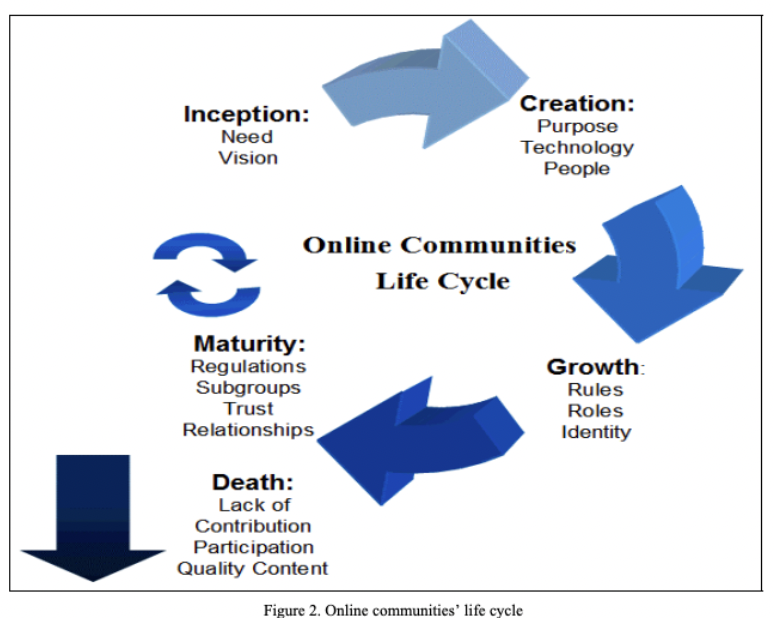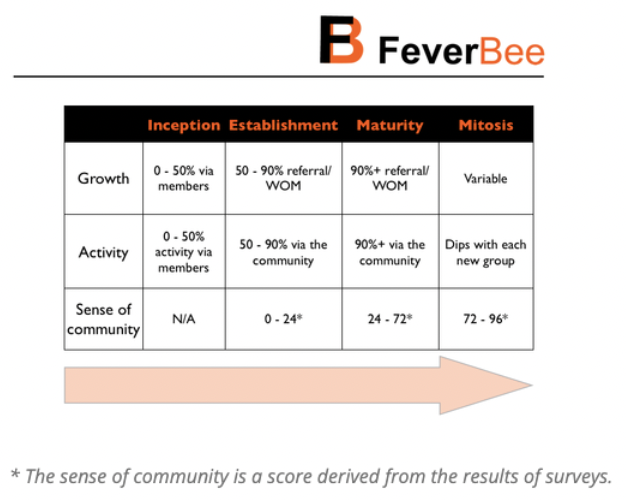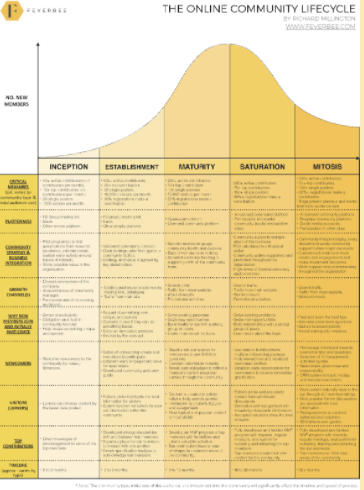The online community life cycle isn’t anything new. Alicia Iriberri and Gondy Leroy applied the information systems lifecycle as a unifying framework and started talking about it back in 2008 in their article A Life Cycle Perspective on Online Community Success.
Other community scientists including Richard Millington of Feverbee have written about The Online Community Lifecycle (2013) and in his book, Buzzing Communities (2012).
He updated his model of the lifecycle as recently. In Building An Online Community: From Getting Started To A Community-First Organization (2018) he includes a stage between maturity and mitosis, called saturation.
It can be a lot to digest, but understanding the life cycle of your online community can help you prioritize your tasks, and set appropriate expectations. When we do our community training with brands, we always include our adaptation of the community lifecycle in the session.
Alicia Iriberri and Gondy Leroy applied the information systems lifecycle as a unifying framework. I use my limited understanding of gardening to the community life cycle that we hope helps you take the right actions at the right time for your community to succeed.
At LCG, we teach organizations about community by referencing four main stages in the community life cycle. Each stage is separated from the next by growth, activity, and sense of community.
Dig into that chart for a minute, and think about where your community is.
OK. Got it?
Yes, each stage tends to be defined by these characteristics, but try not to use the life cycle to judge your community too much. Instead, use it to inform what things you should do. There are particular activities that are most appropriate for a brand to do at each stage of the life cycle the same way that there are different things we have to do when tending a garden. Avoid wasting time or even doing damage to the health of your community by pushing things it isn’t ready for yet. Use the life cycle to guide you about what action to take next in your community.
Stage 1: Inception
The inception stage begins at the launch of your community and generally lasts several months to a year. It starts when you reach out to that first potential member to assess interest. Inception is that first seed you plant. Some organizations start with a brand new community platform; others begin with an existing forum or network that isn’t actively being nurtured or directed by the brand. However, you start, be encouraged. The inception phase is hard work! This is when you are overturning and investigating your soil, looking at what you’re capable of as a brand and doing the work to find the right core group of members. Many want to skip it or rush through this phase because it is unglamorous, the results are uncertain, and progress moves slower than we want. People mistakenly believe that if they create a space for their target audience to commune that they just will. “If you build it, they will come” can still apply here, though. There is a lot of effort in the building process that takes time. Community is a 24/7 operation.
If your community is in the Inception Phase, here’s the primary task list:
Direct growth through individual invites
Initiate discussions
Listen
Prompt participation
Build relationships
Plan for the next stage
The members who are invited to join the group during this stage are essential to your community's growth. Encourage activity and a sense of belonging between the members. Unless a small, active group is established, it will be impossible for your group of people to develop into a successful, long-term community further down the road.
Signs You’re Leaving The Inception Stage
You’ll know this stage is coming to a close when the majority of conversations can happen without brand initiation, and group members are inviting other members to join the group.
If members are not generating activity without direct prompts after about a year, you might want to reevaluate your community concept, tactics, or both.
Stage 2: Establishment
Some folks call it the tipping point, others critical mass. When the community’s level of growth and activity continues to increase without the brand’s direct involvement, your community is in the establishment stage. Your garden has sprouted!
The establishment phase can last a really long time. Different plants need more time than others before harvesting. In the Establishment phase, your community will continue to increase growth and activity, show a sense of community, and be a basis for sustainability.
Some of the ways you water your garden in the establishment phase:
Create content about the community
Organize regular events/activities
Initiate discussions
Prompt participation
Build relationships
Dig into the data
Resolve conflicts
Listen
Empower community member leaders
Direct growth through individual invites
Signs You’re Leaving The Establishment Stage
You’ll know this stage is coming to a close when the vast majority of conversations can happen without your involvement, group members organically invite other members to join the group, and you begin to see a sense of community developing among members.
Stage 3: Maturity
This maturity stage is the point where the community when it consistently bears fruit. At this point in your community, almost all of the activity will be generated by the members. In a mature community sense of community will be present and continue to grow as long as it is cared for. It can and does take years for most communities to reach maturity. That’s ok. There is a lot of value that has come from our established garden.
When your community is mature take time to reflect and adjust:
Optimize the platform
Steer the direction of the community
Transfer power to members / Manage moderators
Re-visit and establish overall goals and vision
Ensure community’s influence within the industry
Many communities remain in this stage for what may feel like forever, and that’s great. As a community builder, the work you do shifts in this phase to be even more directed by members. You’ll begin to put in more effort bringing their ideas for initiatives and events to fruition.
Signs You’re Leaving The Maturity Stage
You’ll know this stage is coming to a close when your community is large and perhaps there is so much to do that members are signaling they want a smaller, more niche place to commune. The same thing happens with plants that need to be divided. They’re crowded and might thrive if they’re given the
Stage 4: Mitosis
Not all communities will reach this stage. At this point, the community is self-sustaining and might need to break apart. This might happen because, in time, sub groups’ needs are not being met by being grouped together. To meet their different needs, you can separate them out and give them more specific experiences. Sometimes this starts as sounds of discontent, so you’ll want to ensure you are deeply listening and trying not to take things personally. Focus on continuing to meet the needs of your members, and you’ll be prepared for the next stage.
During this stage, a community builder will generally:
Identify and create sub-groups
Train and manage leaders
Promote & support sub-groups
Once you’ve established sub-groups and separated them into their own communities, you’ll return to the inception stage as a community builder. The cycle continues! Healthy communities are perennial.
Building community doesn’t come with the immediate gratification that marketing efforts like advertising may bring. Community is a lot more like growing asparagus than it is growing lettuce. Community takes time and is a commitment to building a long-term relationship with your customers/users. It’s ambiguous at times, relies on a lot of listening and interpretation, and quantifying success can be complicated. It does have a predictable and science-based life cycle that if you pay attention to will help you build a successful online community for your brand. Growing a garden isn’t easy, but it is so worthwhile.
We love helping brands wherever their community is in the life cycle. Reach out if we can help you.












